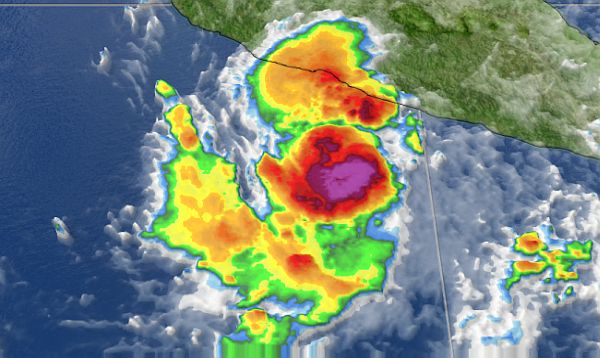Update: Raymond lost hurricane status on Wednesday morning becoming a tropical storm and moving away from the coast on a westerly path over the Pacific Ocean. The storm dropped almost 9 inches of rain on Acapulco and the surrounding areas since Monday, causing significant flooding in some areas before finally beginning to move away on Wednesday afternoon.
Acapulco, Mexico - Hurricane Raymond remained nearly stationary as it spun off Mexico's southern Pacific coast late Monday evening, threatening to spread heavy rains onto a sodden region already devastated by last month's Tropical Storm Manuel.
Guerrero state authorities said it was raining in places, but so far no torrential rains had hit the area. Some streets were flooded in Acapulco, and a few hundred people were evacuated as a precaution from some low-lying coastal areas and isolated mountain towns, authorities said.
The US National Hurricane Center said the Category 3 hurricane had maximum sustained winds of about 120 mph and was edging eastward towards the coast at 2 mph. Raymond was centered about 90 miles south-southwest of the beach resort of Zihuatanejo late Monday evening, and it is expected to follow an erratic path and possibly get closer to the coast on Tuesday, before veering back out to sea Wednesday.
In the beach resort of Zihuatanejo, officials went door-to-door in hillside communities warning residents about the risk of flash floods and mudslides, but nobody had voluntarily evacuated to the three shelters set up in schools and athletic facilities, municipal firefighter Jesus Guatemala said.
Amid light, intermittent rains, tourists continued to stroll through town.
Mexican authorities rushed to deploy emergency crews and said they were considering evacuations of low-lying areas. About 10,000 people already are living away from their homes a month after Manuel inundated whole neighborhoods and caused massive landslides that buried the town of La Pintada. It left behind drenched hillsides that pose even more landslide risks.
 |
| Hurricane Raymond is bringing more rain to Acapulco |
David Korenfeld, head of Mexico's National Water Commission, said on Sunday that officials were pinning their hopes on a cold front moving from the north that could help steer Raymond away from the coast.
"The cold front coming down is what makes Raymond turn to the left - but that is only a model," Korenfeld said. "If that cold front comes down more slowly, this storm can get closer to the coast."
Forecasters say that even if Raymond stays offshore, the storm could dump heavy rain and cause flash flooding and mudslides along the south-central Mexican coast.
"There will be rain for the next 72 hours along the Pacific coast - very heavy rain, torrential rain," Korenfeld said.
A hurricane warning was put into effect from Tecpan de Galeana, up the coast from Acapulco, north to the port of Lazaro Cardenas. A tropical storm warning was posted from Acapulco to Tecpan.
Authorities in Guerrero, where Manuel caused about 120 deaths from flooding and landslides, closed seaports, set up 700 emergency shelters and urged residents in risk areas to take precautions.
The state cancelled classes in most coastal communities west of Acapulco, including Zihuatanejo. Schools are often used as emergency shelters in Mexico.
The potential for damage from such rains is high. About 50 dams in the area are still over capacity, and officials are releasing water to make room for expected rainfall.
Some villages high in the mountains of Guerrero are still without electricity and phone service following Manuel.


